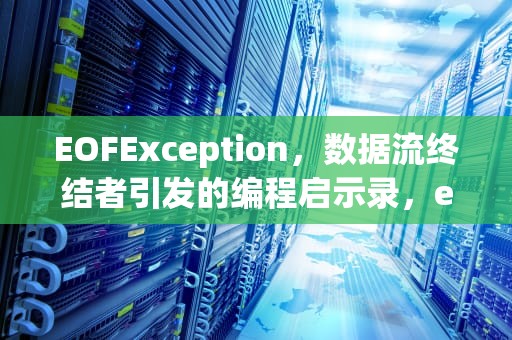本文目录导读:

在计算机科学的世界里,异常处理如同程序世界的免疫系统,当开发者在进行文件操作或网络通信时,常常会遇到一个看似简单却暗藏玄机的异常——EOFException(End Of File Exception),这个标记数据流终结的异常类,既是编程实践中的常见对手,也是理解计算机I/O机制的绝佳入口,本文将深入剖析EOFException的运行机理,揭示其背后的数据流哲学,并通过大量实际案例演示如何优雅应对这种"终结时刻"。
EOFException是Java.IO包中IOException的子类,当输入流意外到达文件末尾或流末尾时抛出,与普通的IOException不同,它明确指示出问题的根源:程序试图读取超出可用数据范围的内容,这种异常的独特性体现在:
当使用DataInputStream读取文件时,如果未正确判断文件长度就强制读取:
try (DataInputStream dis = new DataInputStream(new FileInputStream("data.bin"))) {
while (true) {
int data = dis.readInt(); // 潜在风险点
// 处理数据...
}
} catch (EOFException e) {
System.out.println("正常读取结束");
}
这个典型错误模式展示了EOFException的触发条件:在循环读取中未设置终止条件。
在客户端/服务器架构中,若双方未约定数据长度协议:
// 服务端发送
ObjectOutputStream oos = new ObjectOutputStream(socket.getOutputStream());
oos.writeObject(data1);
oos.writeObject(data2);
// 客户端接收
ObjectInputStream ois = new ObjectInputStream(socket.getInputStream());
Object obj;
while ((obj = ois.readObject()) != null) { // 错误读取方式
// 处理对象...
}
这种缺乏结束标志的通信模式,必然导致客户端在读取时遭遇EOFException。
对象序列化版本不一致时:
class User implements Serializable {
private static final long serialVersionUID = 1L;
// V1版本字段
}
// 序列化存储V1对象后,修改类定义
class User implements Serializable {
private static final long serialVersionUID = 2L; // 修改版本号
// V2版本新增字段
}
// 反序列化旧数据时
try (ObjectInputStream ois = new ObjectInputStream(new FileInputStream("user.dat"))) {
User user = (User) ois.readObject(); // 可能抛出EOFException
}
版本不一致可能导致反序列化提前终止,产生异常。
长度优先法:先读取数据长度元信息
DataInputStream dis = ...; int length = dis.readInt(); byte[] buffer = new byte[length]; dis.readFully(buffer); // 保证完整读取
标记终止法:使用特殊标记值
ObjectOutputStream oos = ...; oos.writeObject(data); oos.writeObject(END_MARKER); // 自定义结束标志
// 接收方 Object obj; while ((obj = ois.readObject()) != END_MARKER) { // 处理对象 }
##### 2. 异常恢复机制
- **断点续传设计**:
```java
long position = 0;
File file = new File("large.data");
try (RandomAccessFile raf = new RandomAccessFile(file, "r")) {
raf.seek(position);
while (true) {
byte[] chunk = new byte[1024];
int read = raf.read(chunk);
if (read == -1) break;
position += read;
// 处理数据块...
}
} catch (EOFException e) {
System.out.println("从位置 " + position + " 恢复");
}使用生产者-消费者模式避免竞争:
BlockingQueue<DataChunk> queue = new LinkedBlockingQueue<>();
// 生产者线程
executor.submit(() -> {
try (InputStream is = ...) {
byte[] buffer = new byte[4096];
int bytesRead;
while ((bytesRead = is.read(buffer)) != -1) {
queue.put(new DataChunk(buffer, bytesRead));
}
queue.put(END_MARKER);
} catch (IOException | InterruptedException e) { ... }
});
// 消费者线程
executor.submit(() -> {
try {
while (true) {
DataChunk chunk = queue.take();
if (chunk == END_MARKER) break;
// 处理数据...
}
} catch (InterruptedException e) { ... }
});
在HotSpot虚拟机中,EOFException的抛出路径:
FileInputStream.read →
Native Method →
Java_java_io_FileInputStream_readBytes →
返回-1时抛出异常具体到ObjectInputStream的实现:
public final Object readObject()
throws IOException, ClassNotFoundException {
// ...
int tc = peekByte(); // 此处检测是否到达流末尾
if (tc == TC_RESET) {
handleReset();
}
if (tc == TC_NULL) {
return readNull();
}
if (tc == TC_ENDBLOCKDATA) {
return throw new EOFException();
}
// ...
}
在Linux系统层面,每个打开的文件对应一个文件描述符(File Descriptor),当调用read()系统调用时:
ssize_t read(int fd, void *buf, size_t count);
返回值为0表示EOF,此时JVM本地方法将转换为EOFException,这个转换过程涉及JNI层的边界检查:
JNIEXPORT jint JNICALL
Java_java_io_FileInputStream_readBytes(JNIEnv *env, jobject this,
jbyteArray bytes, jint off, jint len) {
// ...
n = read(fd, buf + off, len);
if (n == 0) { // EOF检测点
return -1;
}
// ...
}
Python使用EOFError异常,但触发机制有所不同:
try:
while True:
data = file.read(1024)
if not data:
break
# 处理数据...
except EOFError:
print("Unexpected EOF")
特别的是,Python的pickle模块在反序列化时会明确抛出EOFError。
C++通过流状态位检测EOF:
std::ifstream file("data.bin", std::ios::binary);
int value;
while (file >> value) { // 自动检测状态位
// 处理数据...
}
if (file.eof()) {
std::cout << "正常结束";
} else if (file.fail()) {
std::cout << "格式错误";
}
Go使用io.EOF作为特殊错误值:
file, _ := os.Open("data.txt")
reader := bufio.NewReader(file)
for {
line, err := reader.ReadString('\n')
if err == io.EOF {
break
}
if err != nil {
log.Fatal(err)
}
fmt.Print(line)
}
try (DataInputStream dis = ...) {
long storedChecksum = dis.readLong();
ByteArrayOutputStream buffer = new ByteArrayOutputStream();
int b;
while ((b = dis.read()) != -1) {
buffer.write(b);
}
byte[] data = buffer.toByteArray();
long actualChecksum = calculateChecksum(data);
if (actualChecksum != storedChecksum) {
throw new IOException("数据损坏");
}
}
public class ResilientXMLParser {
public Document parse(InputStream is) throws SAXException {
SAXParserFactory factory = SAXParserFactory.newInstance();
SAXParser parser = factory.newSAXParser();
ErrorHandler handler = new DefaultHandler() {
@Override
public void error(SAXParseException e) {
// 记录错误位置
// 尝试跳过损坏部分
}
};
parser.parse(new InputSource(is), handler);
return ...;
}
}
EOFException看似是编程道路上的一个小石子,实则映照出整个数据流处理哲学的深奥本质,从简单的文件读取到复杂的网络通信,从单机程序到分布式系统,正确处理流结束标志始终是保障程序健壮性的关键,随着新技术的不断涌现,EOFException的处理模式将持续演进,但其中蕴含的谨慎设计、边界思维和防御性编程理念,将永远是开发者不可或缺的核心素养。
随着互联网的普及和信息技术的飞速发展台湾vps云服务器邮件,电子邮件已经成为企业和个人日常沟通的重要工具。然而,传统的邮件服务在安全性、稳定性和可扩展性方面存在一定的局限性。为台湾vps云服务器邮件了满足用户对高效、安全、稳定的邮件服务的需求,台湾VPS云服务器邮件服务应运而生。本文将对台湾VPS云服务器邮件服务进行详细介绍,分析其优势和应用案例,并为用户提供如何选择合适的台湾VPS云服务器邮件服务的参考建议。

工作时间:8:00-18:00
电子邮件
1968656499@qq.com
扫码二维码
获取最新动态
